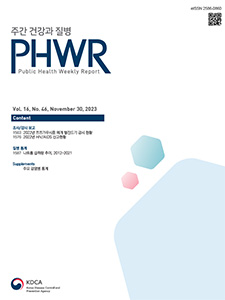Current Issue
Vol.16 No.46, November 30, 2023
-
Surveillance Reports 2023-11-30
 1
1
 392
392
 62
62
Surveillance of Chiggers Density in the Republic of Korea, 2022
Sehoon Cho, Tae-Kyu Kim, Hyunwoo Kim, Jung-Won Ju, Hee-Il Lee
Public Health Weekly Report 2023; 16(46): 1563-1575 https://doi.org/10.56786/PHWR.2023.16.46.1 Abstract
AbstractScrub typhus is an acute febrile disease in autumn. Scrub typhus is spread to people through bites of infected chiggers (larval mites) with Orientia tsutsugamushi. The symptoms are fever, headache, and sometimes rash. In order to survey occurrence of chiggers in the Republic of Korea, chiggers were collected weekly at 18 locations nationwide from August 24 to December 14 in 2022. The number of chiggers collected per trap was calculated for comparison. The period of increasing of chiggers was hurried by 2 weeks compared to 2021. Moreover, after showing the highest occurrence (week 45), it decreased gradually. Of the total 3,723 chiggers were identified as 18 species in 5 genera. Among them, Leptotrombidium scutellare was the dominant species with 1,418 specimens (37.2%). Given the recent an increase in the number of people working outdoors and aging of the rural population, there is a high concern that the number of scrub typhus patients will increase. Therefore, if it is suspected symtoms after being bitten by a mite, it is important to get diagnosed early. And also, because the pattern of vector occurrence has been effected due to climate change, it is important to monitor for mites continuously.
-
Surveillance Reports 2023-11-30
 4
4
 490
490
 177
177
HIV/AIDS Notifications in Korea, 2022
Koun Kim, Sunja Kim, Hwa Su Kim, Seon-Yeo Min
Public Health Weekly Report 2023; 16(46): 1576-1586 https://doi.org/10.56786/PHWR.2023.16.46.2AbstractIn this report, we described the major results of the HIV/AIDS (human immunodeficiency virus/acquired immune deficiency syndrome) cases reported in 2022, based on the ‘2022 HIV/AIDS Annual Report’ published in June 2023. The report stated that in 2022, 1,066 people in the Republic of Korea, were classed with newly detected cases of HIV infection. Among them, 825 cases (77.4%) were Koreans and 241 cases (22.6%) were foreigners. Approximately 92.3% of all cases (984 cases) were men. The proportion of newly detected HIV cases from 20 years old to 39 years old was 66.4%. Among all cases: 30–39 years old age group was 34.9% (372 cases), 20–29 years old group was 31.5% (336 cases), and 40–49 years old group was 16.4% (175 cases) of all cases. There were 761 cases (71.4%) detected in hospitals and 206 cases (19.3%) detected in public health centers. The most common reason for undergoing an HIV test was to confirm the cause of a voluntary physical examination (221 cases, 28.3%). Almost all cases (99.1%, 577 cases) answered their route of transmission was a sexual contact. New HIV infection cases in 2022 increased by 9.3% compared to the cases in 2021. During coronavirus disease 2019(COVID-19), most of the public health centers had to stop their HIV testing, reassigning their manpower to cope with COVID-19 epidemic in the community. HIV detection increased due to the effects of resumption from the second half of 2022.
-
QuickStats 2023-11-30
 0
0
 173
173
 117
117
Trends in intake of sodium, 2012–2021
Public Health Weekly Report 2023; 16(46): 1587-1588 https://doi.org/10.56786/PHWR.2023.16.46.3

pp. 1~2097
Most Keyword
?
What is Most Keyword?
- It is the most frequently used keyword in articles in this journal for the past two years.
Most Read
-
Waterborne and Foodborne Disease Outbreaks in the Republic of Korea, 2023
Myung-Jae Hwang, So Yeon Park, Hyungjun Kim, Se Jeong Yang, Sungchan Yang, Jin Seon Yang
Public Health Weekly Report 2025;18: 17-32 https://doi.org/10.56786/PHWR.2025.18.1.2 -
Implementation Plan for the Coronavirus Disease 2019 Vaccination for the 2024–2025 Season: Recommendations of the 6th Expert Committee on Immunization Practices
Hyewook Hwang, Wookeon Lee, Seohyeon Ahn, Young-Sook Choi, Seunghyun Lewis Kwon, Dongwoo Lee, Eun Hwa Choi, SokGoo Lee
Public Health Weekly Report 2025;18: 90-102 https://doi.org/10.56786/PHWR.2025.18.2.3
Editorial Office
+82-43-719-7569





 Full Text
Full Text Cite
Cite


